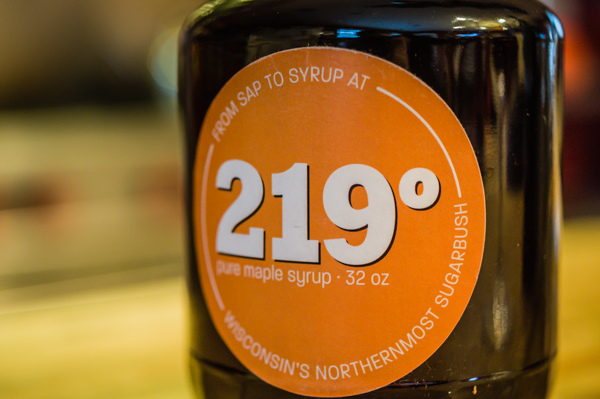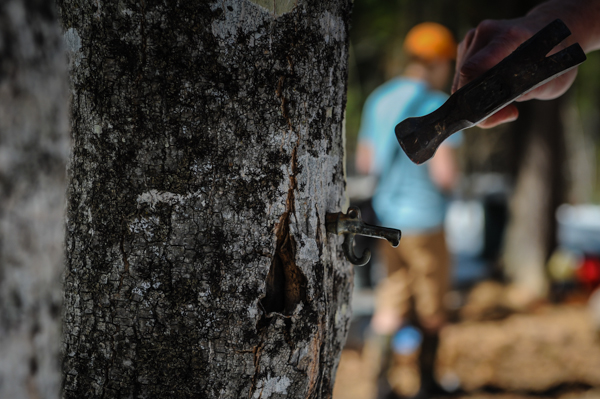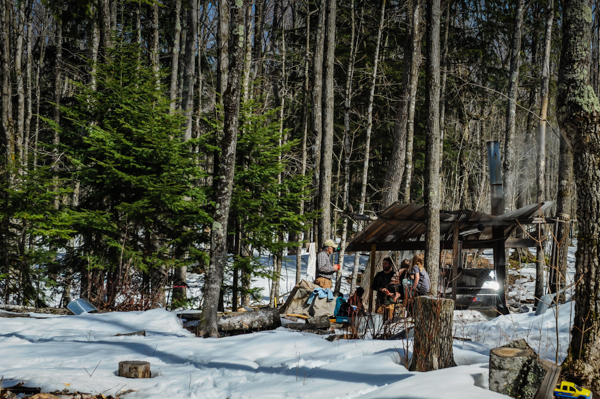There are all sorts of things I've learned since I moved North— don't call the cops when a bear is in the yard, there is no such thing as a perfectly ripe avocado in the grocery stores, saunas are clothing optional and maple syrup really does come from actual maple trees. Okay, I did know about the origins of maple syrup but I hadn't ever actually witnessed the process. Pretty amazing to think that bottle of 219 syrup was in a tree 9 months ago. If you want a little of the northernmost sugarbush in your kitchen, contact Julie (link here) and she'll send it winging your way. A quart of Charly's maple syrup is $18.00 and a 12 ounce jar is $10.00 plus $5.00 for shipping. Trust me, you'll love it.
We met Julie and Charly when Meghan and Caroline were in second grade at a dog sledding/dog biscuit making field trip at Good Thyme (they supplied the dogs and I supplied the biscuits). It was another first for me— dogs, nearly out of their minds with excitement, hooked up to a sled with a bunch of kids on board. It went remarkably well, except for the little hiccup with a pile of greasy scraps behind the dumpster (sled dogs take food very seriously and dishwashers don't know where the dumpster is). That morning, as Charly told us an abridged version of their canoe trip to Saskatchewan, I knew we were on our own journey to a lasting friendship.
The sugarbush is tucked away near the northernmost tip of the Bayfield peninsula. There are pines, maples with metal pails hanging off the taps and a little stream running by the evaporator and wood stove. It was a warm day when we visited in early March— the sap was rolling in the evaporator, wood smoke perfumed the air, the kids built a series of bridges over the stream, George was running amok and Julie and I rinsed out the sap buckets. The whole afternoon felt timeless. Don't me wrong, making syrup is a tremendous amount of work— tapping the trees, hauling buckets (back and forth, back and forth), cutting fire wood, tending the fire, watching the temperature of the syrup and Lord knows what else goes into maintaining a sugarbush but the heart of the process hasn't changed for hundreds of years. Tap trees, build a fire and boil the sap into syrup— it's like traveling back in time.
Charly has started to use tubing to make the sap hauling a lot easier. Buckets are aesthetically pleasing to look at but stumbling through the woods and snow with full buckets of sap would get old.
I prefer maple syrup to sugar, especially in savory dishes— it's not quite as sweet and has a deeper, more intense flavor. Maple syrup shows up in all sorts of places in my kitchen— my favorite winter salad dressing (link here), a fantastic winter salad with poached duck eggs (link here), a fruit and herb stuffed pork loin (link here) and a seriously good caramelized apple bread pudding (link here). It's good stuff and it's even better stuff when you have stood around the evaporator with Charly, drinking sugarbush margaritas while it transforms into syrup.
This is where the magic happens. That wood stove heats the sap in the evaporator to 219 degrees (hence the name of the syrup) and then it comes gushing out (literally) of the pipe into a bucket. Three easy steps that take hours and hours to complete.
Of course, I had to include a George shot. He didn't contribute anything material to our afternoon in the bush but he sure looked handsome.
After the bridge construction in the stream, the kids decided to 'hang' their socks out to dry. It was a surprisingly warm day in March and it felt good to be outside without a jacket on. Maybe that's why sugarbushes are so enchanting— they signal a time when the trees are waking up, the sun is a little higher on the horizon and snow is giving way to the green and muddy earth. Maple syrup— capturing spring awakenings in a bottle.
















